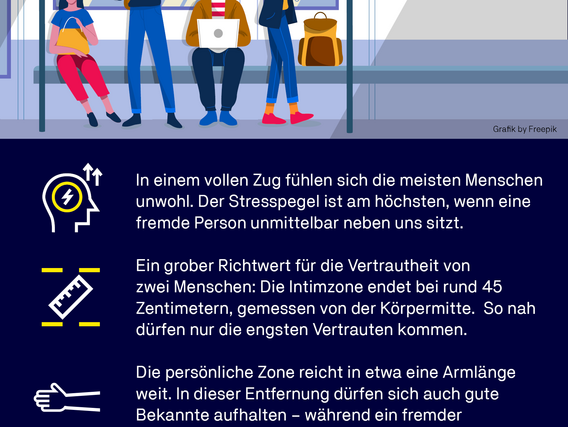Why we don't like sitting next to strangers on the train
Mobilität: Ein Netzwerk im Gehirn überwacht den Sicherheitsabstand zu anderen Menschen: Kommt jemand zu nah, schlägt es Alarm.

Mobilität: Ein Netzwerk im Gehirn überwacht den Sicherheitsabstand zu anderen Menschen: Kommt jemand zu nah, schlägt es Alarm.

Most people feel uncomfortable on a crowded train. This is even reflected in their physical stress reactions, as US researchers from Cornell University observed in 2007. The two psychologists asked working people commuting to New York by train how they were feeling and analysed their saliva for stress hormones. The surprising result: it was not so important how crowded the carriage was. Rather, the stress level depended on whether a stranger was sitting right next to them.
‘The person in the neighbouring seat invades the invisible safety zone that we claim for our own bodies,’ explains Christian Müller from the Medical-Psychological Institute of TÜV NORD in Cologne. In technical jargon, this zone is called the ‘peripersonal’ space, says the psychologist. ‘We only tolerate strangers there if there is a good reason for physical proximity, such as on a crowded train, in a cramped lift or during a medical examination. That's why it's also an unwritten law not to sit directly next to a stranger as long as there's still a two-seater seat available.’
This safety zone was first described in the 1950s by a Swiss zoologist, Heini Hediger: the zoo director discovered that animals living in captivity kept a certain distance from each other. In the 1960s, the US anthropologist Edward T. Hall developed his own specialist field from this discovery: the psychology of human spatial behaviour, or ‘proxemics’ for short. According to this, the familiarity between two people is reflected in their physical proximity.

Difference between ‘friend and foe’
However, what is considered close differs from culture to culture. A rough guideline: the intimate zone ends at around 45 centimetres, measured from the centre of the body. Only the closest confidants are allowed to get that close. The personal zone is about an arm's length away. Even close acquaintances are allowed to stay within this distance - whereas a stranger intruding here always causes discomfort.
This is due to a system in our brain that monitors the space around us. This neuronal network between the occipital and frontal lobes becomes active as soon as a person comes inappropriately close to us. The nerve cells in this network collect information from various sensory channels such as the skin, eyes and ears, linking them with each other and with our own movements in space. Even signals that we do not consciously perceive can be processed in the process.
Just like a security camera, the network images what is happening in the immediate vicinity, especially in the safety zones around the face, upper body and arms. However, there is not just an inside and outside, but gradual gradations: The closer a stranger comes, the stronger the alarm. The minimum distances are also not fixed for all times, but can be changed: for example, tools or a prosthesis can extend the body and thus also the peripersonal space.
Body signals provide information about protection zones
The protective zone also grows when someone feels vulnerable, for example in the last trimester of a pregnancy. However, it can also differ permanently from one person to another. Suspicious personalities, for example, need a greater minimum distance, as do people suffering from schizophrenia: They are also less able to cope when someone crosses their boundaries.
Such differences are particularly visible on public transport. ‘When it gets too crowded, people create distance in other non-verbal ways: they avoid eye contact, cross their arms and turn their bodies away,’ reports Christian Müller from TÜV NORD. ‘For some, the proximity is so difficult to bear that they prefer to stand still. This allows them to move out of the way to restore the necessary minimum distance.’
A journey by bus or train therefore always provides enough material for a psychological field study. The psychologist advises: ‘If you are sitting on a full train, observe - discreetly, of course
Founded over 150 years ago, we stand for security and trust worldwide. As a knowledge company, we have the digital future firmly in our sights. Whether engineers, IT security experts or specialists for the mobility of the future: in more than 100 countries, we ensure that our customers become even more successful in the networked world